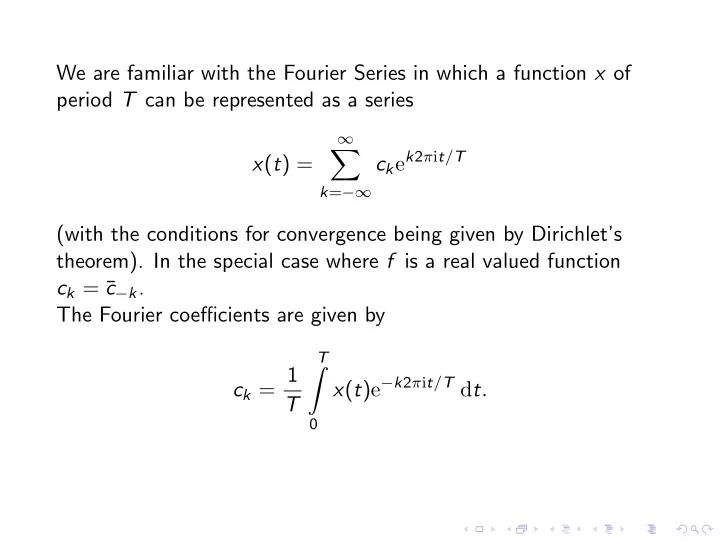

We are familiar with the Fourier Series in which a function x of period T can be represented as a series � ∞ c k e k 2 π i t / T x ( t ) = k = −∞ (with the conditions for convergence being given by Dirichlet’s theorem). In the special case where f is a real valued function c k = ¯ c − k . The Fourier coefficients are given by � T c k = 1 x ( t ) e − k 2 π i t / T d t . T 0
� e 2 π k i ( n − 1) / N � N C N ( the vectors u k = 1 n =1 form an orthonormal N basis with respect to the standard inner product. We can therefore regard a sequence of N samples of a function f , x = ( x ( t 0 + ( n − 1) δ )) N n =1 as a vector (here δ is the sampling interval) and define the Discrete Fourier Transform DFT of x as x = ( x · u n ) N n =1 ∈ C N ˆ (1) Then we have � N x = x k u k . ˆ (2) k =1
The Fourier Transform is defined by � ∞ x ( t ) e − 2 π i st d t ˆ x ( s ) = −∞ and can be inverted using the Inverse Fourier Transform � ∞ x ( t ) = 1 x ( s ) e 2 π i st d t . ˆ 2 π −∞
A cos(2 π ft + φ ) is said to have amplitude A , frequency f and phase φ More generally consider cos θ ( t ), where typically θ ( t ) = 2 π f 0 t + φ ( t ). We define the instantaneous frequency as f inst ( t ) = θ ′ ( t ) = f + φ ′ ( t ) 2 π 2 π With this interpretation, if you have a signal m ( t ) and you want to frequency modulate a sinusoidal signal with frequency f 0 , the modulated signal is � t f 0 t + x FM ( t ) = cos 2 π m ( t ) d t 0
The Hilbert Transform of a real function x ( t ) is defined by � ∞ x ( s ) Hx ( t ) = P.V. t − s ds , −∞ also � Hx ( s ) = − i sign ( s )ˆ x ( s ) which makes a numerical approximation easier to calculate If x ( t ) is a real valued signal the complex signal z ( t ) = x ( t ) + i Hx ( t ) is a complex analytic function restricted to the real axis. If z ( t ) = exp i θ ( t ) instantaneous phase is then θ ( t ) = arg z ( t )
Recommend
More recommend